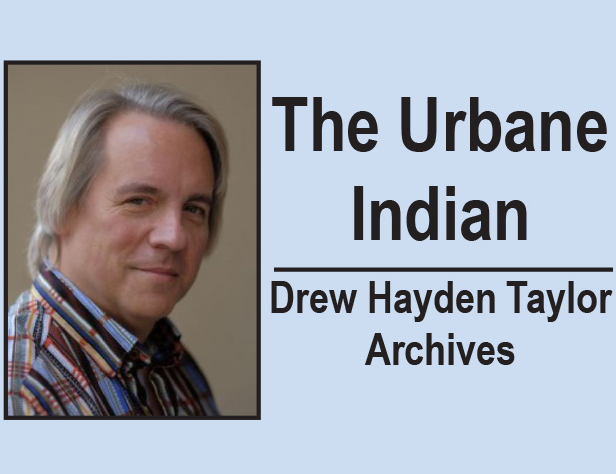
By Drew Hayden Taylor
Originally published in September 2010
This has been an unusual time in the world of Aboriginal reconciliation. It’s no secret that there’s a lot out there in the First Nations community to be reconciled, and sometimes the process is fraught with sudden difficulties and unexpected surprises.
It’s been that way since 1492, or 1497, Newfoundland time. We’ve had recent examples of both the good and the bad.
June 11th was the twentieth anniversary of what became known as the Oka Crisis. The little Mohawk community of Kahnesatake, in a dispute with the town of Oka, the province of Ontario, and the Government of Canada, blockaded an area of the town known as the Pines, severely inconveniencing several dozen potential middle-class white golfers who were anticipating an additional nine holes to be built over a traditional burial ground.
These people should have spent less time on the golf course and more time watching movies like Poltergeist. Native burial grounds and White developers don’t mix. Check out section 666 of the Indian Act.
The unfortunate outcome was a 78-day siege, the tragic death of provincial police officer Corporal Marcel Lemay, an army invasion, and an estimated bill for the taxpayers somewhere in the six digits. That’s one hell of a green fee. Two decades later progress has been made, but not all the wounds have healed completely.
And then there’s Francine Lemay, sister of the Corporal Lemay. There’s a lot of healing and reconciliation in that woman. By all rights, she should be the last person wanting to mend relations, yet, she has done something fabulous. A translator by trade, she has personally translated the book At The Wood’s Edge into French, which details the Mohawk community’s history and struggle for justice.
Before the incidents at Oka, she knew very little about the Mohawk people or their history, but a chance meeting with some Mohawk women a year or so ago at a local Church proved pivotal. Francine Lemay talked with those women, read the book seeking to understand their perspective, and afterwards offered to translate it so other French people could understand what had led up to those tragic events. It was truly an amazing gesture by a woman, who by all reckoning, should be very angry. That sounds like true reconciliation.
And then there is the recent revelations about the Truth and Reconciliation Commission on Indian Residential Schools. It seems the last thing on their personal agenda is reconciliation, at least within their own organization. More people have left the organization amidst bad publicity. Originally set up in 2009 to record and research the events and abuses that occurred at the dozens of residential schools scattered across the country, the Commission got off to a bad start almost immediately when the three original commissioners resigned due to internal squabbling. This set the Commission back almost a year, endangering the completion of their five-year mandate.
Now two more individuals have decided, or have been told, too much truth is not necessarily a good thing in their lives. Dr. John Milroy, the research director, has opted to seek greener pastures. Only a few months into his job, he came under fire for making some controversial remarks over his frustration at the pace of document negotiations. He thought the Catholic Church was taking too long releasing diaries, lest they reveal details about “buggering boys in the basement and that sort of thing.”
An apology by Commission Chair Mr. Justice Murray Sinclair to the Church soon followed. Though still an official adviser on research to the Commission, Dr. Milroy’s contribution to ‘reconciliation’ has been downgraded. About his departure, both the Commission and Dr. Milroy blamed the unexpected amount of administrative work involved.
Add to that, executive director Tom McMahon has been replaced by Kim Murray, a lawyer from, ironically, the Kahnesatake First Nation of Oka. Mr. McMahon will also stay on in an advisory capacity. Granted there is a fair amount of shuffling that goes on in any large organization, but all these exits and entrances seem a little too frequent and a little too high up the ladder.
All this changing of the guard takes the focus away from the important issues of detailing and recording the many unfortunate stories that come from the thousands of former students forcibly enrolled in the schools where, in many cases, they were physically, mentally and sexually abused. There is a saying in the world of Native theatre, ‘before the healing can take place, the poison must be exposed.” Physician, heal thyself. As things stand now, a report the Commission is scheduled to deliver at the end of its second year on its ‘historic findings’ is looking less and less likely.
Maybe they should bring Francine Lemay in to have a good talk with them. It wouldn’t hurt.
